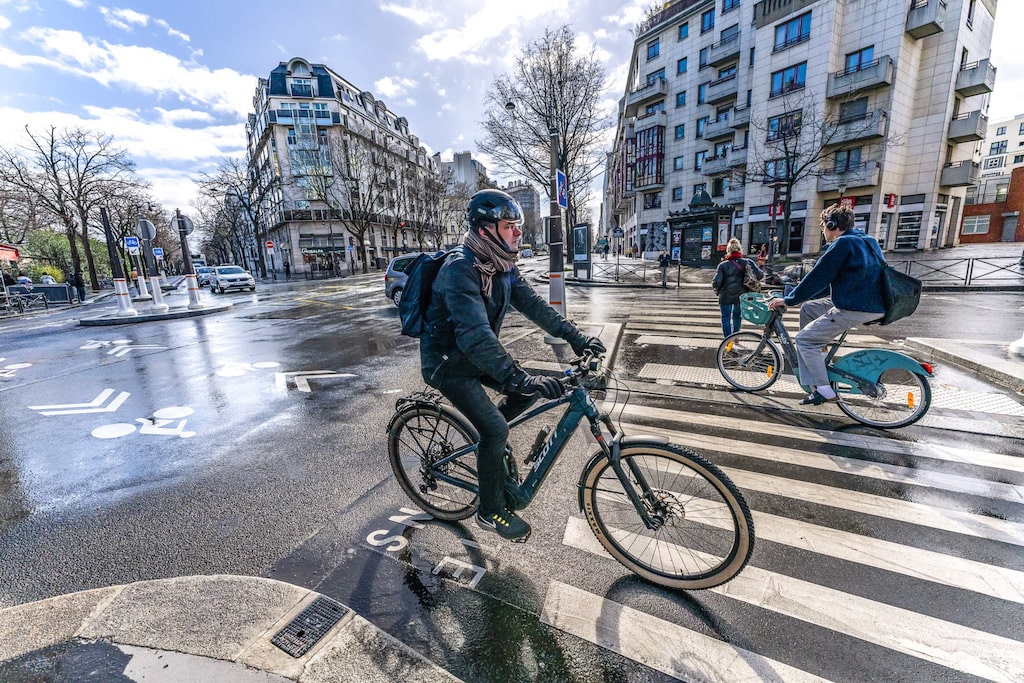Autumn Gear Guide
Find inspiration in our Gear Guide that will keep you out on your bike through wind or rain.
Download NowThe Euro 2024 Championship (of soccer/football) is set to kick off this weekend, and national pride is on the line as teams from across the continent compete. Sure, we could talk about soccer, but that’s not really our thing. Our thing is urban cycling. So we decided to rank the participating countries, or at least […]
The Euro 2024 Championship (of soccer/football) is set to kick off this weekend, and national pride is on the line as teams from across the continent compete. Sure, we could talk about soccer, but that’s not really our thing. Our thing is urban cycling. So we decided to rank the participating countries, or at least the top 10, as cycling-friendly nations.
Here’s a look at the top Euro 2024 countries leading the way with rankings based on culture and acceptance as well as infrastructure, and policies. This is not a scientific study, so please don’t come at us. But it is good to shine a light on those leading the way, hopefully for other countries to follow.
The Netherlands has long been synonymous with cycling, deeply ingrained in the national identity since the early 20th century. With flat terrain and a robust cycling culture, cities like Amsterdam and Utrecht are world-renowned for their extensive and well-maintained bike infrastructure.
Cities: Amsterdam, Utrecht, Rotterdam
Infrastructure: The Netherlands boasts over 35,000 km of cycle paths. In Amsterdam, an astounding 63% of residents use their bikes on the daily. Utrecht’s bicycle parking at the central station holds 12,500 bikes, the largest in the world.
Policies: The Dutch government invests heavily in cycling infrastructure, including safe intersections and bike lanes. The country spends more than €500 million annually on cycling infrastructure every single year. Go Team Orange!
Cycling is a way of life in Denmark, especially in Copenhagen, where bicycles outnumber cars. The Danish capital is a global model for urban cycling, with a commitment to sustainability and healthy living.
Cities: Copenhagen, Aarhus, Odense
Infrastructure: Copenhagen has 675 km of cycle tracks and lanes. Around 62% of Copenhageners cycle to work or school daily. The Cycle Superhighways project aims to connect suburbs to the city center with dedicated bike lanes.
Policies: Denmark spends around €36 per capita annually on cycling infrastructure, ensuring high-quality, well-maintained routes.
Germany’s embrace of urban cycling is a blend of efficiency and environmental consciousness, with Berlin leading the charge. The country has invested significantly in its cycling infrastructure, making it safer and more accessible for everyday commuters. The host country is ranked third, which coincidentally, is also the team’s ranking in terms of their odds to win the Euro title. Synchronicity.
Cities: Berlin, Hamburg, Munich
Infrastructure: Berlin has over 1,200 km of bike paths, and Hamburg is aiming for a 25% modal share for cycling by 2025. Munich’s RadlRing offers a 170 km long cycle route around the city.
Policies: The German government’s National Cycling Plan 3.0 aims to double the number of cyclists by 2030, supported by investments of €1.46 billion from 2020 to 2023.
France, we write about them so much. Cities are bursting with bike lanes and the culture is really taking root. But they do have some catching up to do. Paris’s ambitious cycling plans reflect a broader national movement towards sustainable and active transport, and we are loving every minute of it. Five years from now, these rankings could look decidedly different.
Cities: Paris, Lyon, Bordeaux
Infrastructure: Paris has expanded its cycling network to over 1,000 km. The “RER V” project aims to create nine express cycle routes covering 680 km by 2024.
Policies: The French government launched the “Plan Vélo” with an investment of €350 million to improve cycling infrastructure and safety.

Paris, France
Belgium’s cycling culture is robust, with Flanders and Brussels as key urban cycling hubs. Recently, Brussels move to oust the automobile from the city center has proven to be a huge hit. The country’s historical association with cycling, particularly through its famous races, translates into strong support for everyday urban cycling.
Cities: Brussels, Antwerp, Ghent
Infrastructure: Brussels has 218 km of cycle paths with a goal to reach 400 km by 2030. Antwerp’s bike share scheme, Velo, has 4,000 bikes available for hire.
Policies: Belgium supports cycling through subsidies for bike purchases and extensive bike-sharing programs. Antwerp aims to have a 50% increase in cyclists by 2030.
Spain’s cities are embracing urban cycling as a sustainable and healthy mode of transport, with Barcelona and Seville leading the way. The country’s cycling infrastructure was expanding rapidly, supported by strong municipal initiatives. But with a change in government, the country needs to step up its advocacy efforts to make sure it doesn’t go backwards.
Cities: Barcelona, Valencia, Seville
Infrastructure: Barcelona has 240 km of cycle lanes, aiming to reach more than 300 km by 2024 and the city has an awesome new quiet streets plan in the works. Seville’s cycling network covers 180 km with plans for expansion.
Policies: Spain’s government supports urban cycling through various regional initiatives and bike-sharing systems like Bicing in Barcelona.
Sweden’s commitment to sustainability and active living is reflected in its growing urban cycling infrastructure. Cities such as Stockholm and Malmö are making cycling a practical and popular mode of transport year-round.
Cities: Stockholm, Gothenburg, Malmö
Infrastructure: Stockholm has 1,000 km of cycle paths, and Malmö is known for its extensive cycling network and high cycling rates among residents.
Policies: Sweden’s government invests in cycling infrastructure through the “Swedish Cycling Strategy,” with a focus on safety and accessibility.
The UK’s urban cycling scene is rapidly evolving, with London and Manchester leading the way. Significant investments in cycling infrastructure and policies are transforming the urban landscape to accommodate more cyclists.
Cities: London, Manchester, Bristol
Infrastructure: London has over 1,400 km of cycle routes, including the ambitious Cycle Superhighways. Manchester’s Beelines project plans to create 1,800 miles of cycling and walking routes.
Policies: The UK government has pledged £2 billion to improve cycling and walking infrastructure by 2025.
Austria’s scenic cities are becoming more cycle-friendly, with Vienna leading the charge in urban cycling initiatives. The country’s investments in cycling infrastructure reflect a growing commitment to sustainable urban mobility.
Cities: Vienna, Graz, Salzburg
Infrastructure: Vienna offers over 1,300 km of cycle paths, and the city aims to increase the cycling share to 20% by 2025.
Policies: Austria supports cycling through national and regional initiatives, including the “klimaaktiv mobil” program, which promotes sustainable mobility.
Italy’s rich cycling heritage, celebrated through events like the Giro d’Italia, is now fueling a growing urban cycling culture. Cities like Milan and Turin are reportedly investing heavily in cycling infrastructure to promote sustainable urban transport. But, the streets are still dominated by automobiles and change is not happening fast enough on the local level.
Cities: Milan, Turin, Bologna
Infrastructure: Milan has 220 km of cycle paths and plans to reach 750 km by 2035. Turin’s bike-sharing program, ToBike, has 130 stations and over 1,200 bikes.
Policies: Italy promotes cycling through the “Bike to Work” initiative, offering financial incentives for cycling commuters.
Through these rankings we hope to highlight that although European countries are moving in the right direction, some are leading the race, while others are trying to catching, and others still are just plodding along oblivious to what’s happening and how investing in bicycle infrastructure can be a game changer. This is only the top 10. There are 14 other countries and the investment and commitment to transportation cycling dives down.
The European Union has approved a Declaration on Cycling and that’s huge. It recognises the importance of the humble bicycle as “a sustainable, accessible and inclusive, affordable and healthy means of transport, with strong added value for the EU economy.” So hopefully other countries in Europe and around the world will see what’s happening in the Netherlands, or even in host country Germany, and move in the right direction.
With extensive infrastructure, supportive policies, and a strong cycling culture, these nations are leading the way in making cities more bike-friendly, enhancing the quality of life for residents, and promoting sustainable transportation.
Make no mistake, the bicycle can and is changing the world. That’s the GOALLLLLL!
Find inspiration in our Gear Guide that will keep you out on your bike through wind or rain.
Download Now



Leave a comment